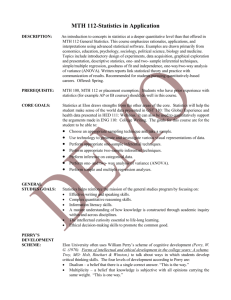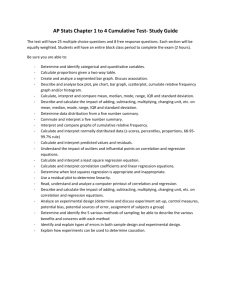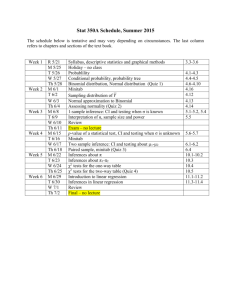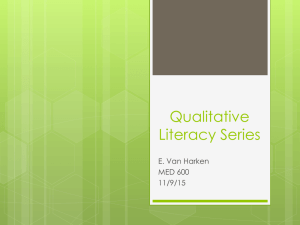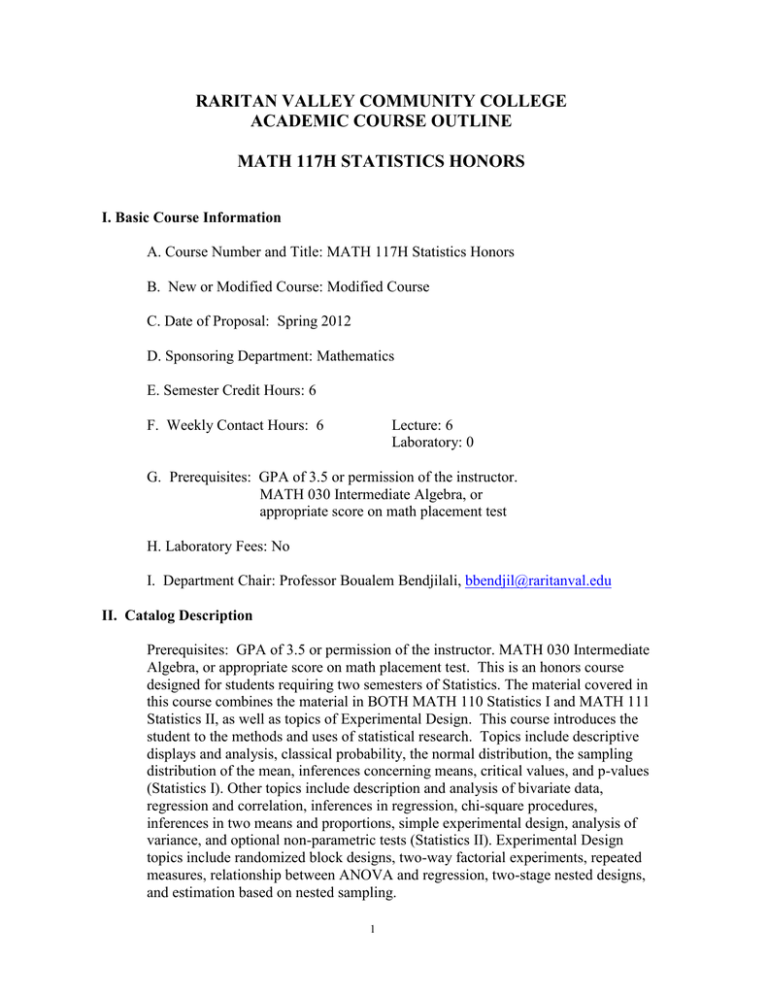
RARITAN VALLEY COMMUNITY COLLEGE
ACADEMIC COURSE OUTLINE
MATH 117H STATISTICS HONORS
I. Basic Course Information
A. Course Number and Title: MATH 117H Statistics Honors
B. New or Modified Course: Modified Course
C. Date of Proposal: Spring 2012
D. Sponsoring Department: Mathematics
E. Semester Credit Hours: 6
F. Weekly Contact Hours: 6
Lecture: 6
Laboratory: 0
G. Prerequisites: GPA of 3.5 or permission of the instructor.
MATH 030 Intermediate Algebra, or
appropriate score on math placement test
H. Laboratory Fees: No
I. Department Chair: Professor Boualem Bendjilali, bbendjil@raritanval.edu
II. Catalog Description
Prerequisites: GPA of 3.5 or permission of the instructor. MATH 030 Intermediate
Algebra, or appropriate score on math placement test. This is an honors course
designed for students requiring two semesters of Statistics. The material covered in
this course combines the material in BOTH MATH 110 Statistics I and MATH 111
Statistics II, as well as topics of Experimental Design. This course introduces the
student to the methods and uses of statistical research. Topics include descriptive
displays and analysis, classical probability, the normal distribution, the sampling
distribution of the mean, inferences concerning means, critical values, and p-values
(Statistics I). Other topics include description and analysis of bivariate data,
regression and correlation, inferences in regression, chi-square procedures,
inferences in two means and proportions, simple experimental design, analysis of
variance, and optional non-parametric tests (Statistics II). Experimental Design
topics include randomized block designs, two-way factorial experiments, repeated
measures, relationship between ANOVA and regression, two-stage nested designs,
and estimation based on nested sampling.
1
III. Statement of Course Need
This course is a general education mathematics course and serves as a math
requirement for various A.S. and A.A. programs. This course will generally transfer
as a mathematics course.
Honors courses in mathematics have been developed to provide mathematically
talented students the opportunity to obtain a level of rigor not currently available in
existing courses.
IV. Place of Course in College Curriculum
A. This course serves as a free elective.
B. This course serves as a General Education course in Mathematics.
C. This course meets a program requirement for various A.S. and A.A. degree
programs.
D. To see course transferability: a) for New Jersey schools, go to the NJ Transfer
website, www.njtransfer.org; for all other colleges and universities, go to the
individual websites.
E. This course is an honors course.
V. Outline of Course Content
A.
B.
C.
D.
E.
The Nature of Statistics
Organizing Data
1.
Sampling Techniques
2.
Grouping Data
3.
Histograms and other graphs
4.
Stem and Leaf Diagrams
Descriptive Measures for Univariate Data
1.
Summation Notation
2.
Measures of Central Tendency
3.
Measure of Dispersion
4.
Interpretation of Standard Deviation and Chebychev’s theorem
5.
Grouped Data Formulas
6.
Quartiles and Box-and-Whisker Diagrams
7.
Parameters and Statistics
Probability
1.
Classical Probability
2.
Rules of Probability
3.
Mutually Exclusive Events
4.
Conditional Probability
5.
Independent Events
Discrete Random Variables
1.
Probability Distributions
2.
The Mean and Standard Deviation of Discrete Random Variables
3.
Bernoulli Trials and Binomial Coefficients
2
F.
G.
H.
I.
J.
K.
L.
M.
N.
4.
The Binomial Distribution
The Normal Distribution
1.
From Discrete to Continuous Random Variables
2.
The Standard Normal Curve
3.
Finding Areas Under the Normal Curve
4.
Normally Distributed Random Variables
The Sampling Distribution of the Mean
1.
Random Sample and Sampling Error
2.
The Mean and Standard Deviation of the Sample Mean
3.
The Central Limit Theorem
Estimation
1.
Point and Interval Estimation of a Parameter
2.
Constructing Confidence intervals for Population Means
3.
The t-Distribution
4.
Sample Size Considerations
Hypothesis Testing – Statistical Inference
1.
Nature and Design of Hypothesis Tests – classical and p-value
methods
2.
Tests for Single Means and Single Proportions
3.
Interpretation of Results
4.
Type I and Type II Errors
5.
Power analysis
Inferences About Two Population Means
1.
Independent and Dependent Samples
2.
Tests for Differences between Two Means
3.
Tests for Differences between Two Proportions
4.
Tests for standard deviations
5.
Chi-square procedures
Inferences About More Than Two Population Means
1.
The F-Distribution
2.
The Logic behind Analysis of Variance
3.
One-Way ANOVA
4.
Two-Way ANOVA
5.
Randomized blocks
6.
Two-way factorial experiments
7.
Repeated measures
Descriptive Measures for Bivariate Data
1.
Scatter plots
2.
Linear Equations with One Independent Variable
3.
The Regression Equation
4.
The Correlation Coefficient
5.
The Coefficient of Determination
Inferences for Regression and Correlation
1.
Standard Error of the Estimate
2.
Inferences for Regression and Correlation Coefficients
3.
The model for Multiple Regression
4.
The relationship between ANOVA and regression
Nested Sampling
3
1. Two-stage nested designs
2. Estimating a population mean based on nested sampling
VI. Educational Goals and Learning Outcomes
A. Educational Goals
Students will:
1.
Use appropriate methods of statistics for various analyses (GE-NJ 2)
2.
Solve problems quantitatively and symbolically. (GE-NJ 2)
3.
Research, evaluate, and effectively utilize information needed to
complete a statistical analysis. (GE-NJ IL)
4.
Communicate statistical findings in both writing and speech. (GE-NJ
1)
B. Learning Outcomes
Students will be able to:
1.
Synthesize descriptive methods of statistics for the purpose of
organizing and summarizing data. (GE-NJ 2)
2.
Interpret the meaning of summary measures (mean, median, mode,
standard deviation, variance, quartile, percentile, range, minimum,
maximum, outlier, etc.) within the context of problem. (GE-NJ 2)
3.
Calculate the probability of an event using both discrete and normal
distribution methods. (GE-NJ 2)
4.
Interpret results from inferential statistics to interpret data for the
purposes of interval estimation in means and proportions. (GE-NJ 2)
5.
Interpret results from inferential statistics to interpret data for the
purposes of decision-making in hypothesis tests, including
independent and or dependent means, and one or two proportions.
(GE-NJ 2)
6.
Conduct an appropriate hypothesis test using both classical and
modern (p-value) procedures. (GE-NJ 2)
7.
Interpret results from inferential statistics to interpret data for the
purposes of decision-making in Chi-Square tests for independence or
goodness-of fit. (GE-NJ 2)
8.
Interpret results from inferential statistics to interpret data for the
purposes of decision-making for a one-way ANOVA analysis. (GENJ 2)
9.
Use linear regression techniques for purposes of analysis and
prediction for slope or correlation. (GE-NJ 2)
10.
Conduct a simple statistical study (experimental or observational),
including the sampling design, interpretation of computer results from
collected data, and inference from these results to a conclusion
consistent with the design. (GE-NJ 2; GE-NJ IL)
11.
Explain and present (written and verbal) statistical results from own
experimental design study. (GE-NJ 1)
4
VII. Modes of Teaching and Learning
Instructors can use a variety of modes including, but not limited to the following:
A. lecture/discussion
B. small-group work
C. computer-assisted instruction
D. student oral presentations
E. student collaboration
F. independent study
G. homework
VIII. Papers, Examinations, and other Assessment Instruments
Student learning outcomes are assessed using a combination of the following:
A. teacher written tests
B. computer/calculator assignments
C. semester projects
D. final examination
E. in-class or online quizzes & homework
IX. Grade Determinants
Final grades are determined by a combination of the following:
A. tests
B. quizzes
C. homework
D. projects
E. assignments
F. cumulative final exam
X. Texts and Materials
A. Suggested textbook: Introductory Statistics, (latest edition). Neil A. Weiss.
Pearson Addison-Wesley.
B. Computer-based sources: The instructor is free to choose the type of technology.
Choices include but are not limited to:
1. MINITAB
2. TI-84 graphing calculator
3. EXCEL
4. IBM SPSS
5. SAS
Please Note: The course outline is intended only as a guide to course content and
resources. Do not purchase textbooks based on this outline. The RVCC Bookstore is
the sole resource for the most up-to-date information about textbooks.
XI. Resources
5
Because of the technology used in the course, classes should be held in a CATT
room where the instructor can access both MINITAB and the web. MINITAB
software needs to be available in S020, the open lab, and any other computer lab
where students may be working.
6


